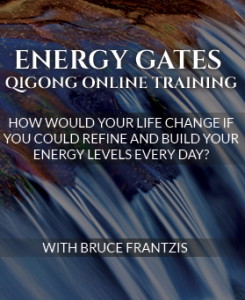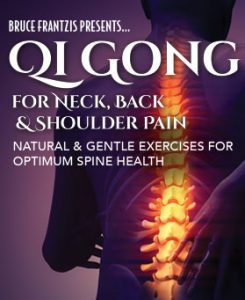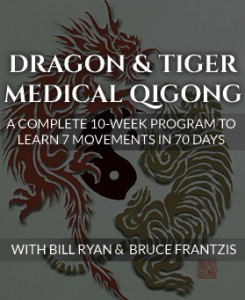Qigong exercises such as Energy Gates Qigong and Dragon & Tiger Medical Qigong are among the most efficient and powerful health maintenance exercises anyone is likely to find. They are gentle, low impact exercises that are easy on the joints and can be done by people who cannot do other forms of aerobic exercise or yoga, and by the sick or injured.
Starting Qigong After 50
Qigong can do wonders to rejuvenate the elderly. In fact, more than 50 percent of the people who begin tai chi and qigong in China do so after the age of 60, when the realities of aging can no longer be pushed aside. Already, hundreds of millions of people over the age of 60 have found qigong to be uniquely effective.
If a form of exercise can make the old functionally younger, its effect on the young or middle-aged is inestimable. If nothing else, it is guaranteed to help release stress, as well as improve your sex life.
Gentle Qigong Exercise
Gentle qigong exercises like Energy Gates Qigong can even be adapted for use by the bedridden in hospitals. They are quite safe. Anyone can do them. This is not the case with some types of qigong or tai chi, which, without the constant supervision of a teacher, may cause significant damage.
The chi flow in the body may be likened to an electrical system. If there is not enough insulation on the wires, or the circuits are connected improperly, the system can short-circuit or otherwise malfunction. Obviously, you do not want this happening to your body.
Although there are hundreds of qigong systems, the techniques they use (which have countless names) can be boiled down to five or six basic types. Some qigong systems require that a teacher meet regularly with no more than a few students at a time in order to prevent potential damage. There are qigong systems that must only be begun before puberty. There are methods that are inappropriate for certain groups to practice, such as males, or females, or people with specific health problems, or people of certain emotional dispositions, or people who have been injured physically or mentally. The exercises presented in the Energy Gates series are the best that could ethically be put in print for the general public, as they can be practiced by almost anyone, which is as safe as any qigong system gets.
The West’s Growing Medical Crisis
Until about 1980, the medical systems of the United States and Europe ran reasonably well. Up to that time, the over-60 population fluctuated at somewhere below ten percent of the total population.
As the baby boomers age, the percentage of elderly in the population continues to rise. According to the U.S. Census Bureau, in 1993, one in eight Americans was older than 65; by 2030, the number is expected to be one in five—70 million elderly or 20 percent of the population!
Older people require significantly more medical attention for the same illness than younger people do. For example, a thirty-year old with liver problems, even caused by alcohol, might need a week or two in a hospital. However, a person over sixty could need four to six weeks for the same problem. The deterioration of our medical system is partly due to this simple fact.
Epidemic of Chronic Diseases
According to the Centers for Disease Control and Prevention, chronic diseases are the cause of 70 percent of deaths of our elderly. These are generally life-style diseases that are not caused by infection. They have long, debilitating courses and are rarely cured. These diseases include arthritis, asthma, heart disease, high blood pressure, poor circulation and depression. They are termed life-style diseases because they are caused by living and working in unhealthy environments or by stress, alcohol, tobacco, poor diet or lack of exercise.
Chronic diseases cause great human suffering for the people that have them and for those that love and care for them. Chronic diseases now have a severe impact on the lives of countless children and young adults.
The amount of money spent on doctors, hospital stays and pharmaceuticals to mitigate chronic disease is enormous. For example, arthritis, which limits the activity of over seven million people, is second only to heart disease as a cause of worker disability. By 2020, an estimated 60 million Americans will be affected by arthritis and more than 11 million will be disabled by it. Recent estimates place the direct medical cost of arthritis at $15.2 billion per year, with total costs of medical care and lost wages exceeding $64 billion.
If people take measures to better care for themselves and mitigate stress and arthritis, more health care money will be available for research, infectious disease prevention, surgery, etc.
Qigong: An Ideal Health Exercise
New ways must be found to enhance and maintain fitness among the elderly. According to the National Center for Health Statistics, Data Warehouse on Trends in Health and Aging, in 1998, 69.2 percent of Medicare beneficiaries sixty-five and over had trouble stooping and 45.6 percent had trouble walking. In 1998, over 30 percent reported having difficulty with heavy housework and about 18 percent reported difficulty with shopping.
Qigong is a great alternative health practice that can help people take control of their well-being, stay healthy and prevent or mitigate chronic illness.
Health Insurance and Health Crisis?
Insurance companies keep increasing their rates dramatically, particularly for people over fifty. Moreover, in 2005, one in six people in America did not have health care insurance, and these numbers are expected to get worse.
If the trend continues, people will not be able to afford health insurance unless they are very wealthy.
The statistics speak volumes about the growing costs of health care and the desire of health insurance companies to avoid bearing the burden of those costs.
This leads to some very basic questions, which every Westerner should seriously consider. For example:
- Is my health my responsibility or the responsibility of others?
- Can I trust my health to insurance companies and HMOs that have excellent financial reasons to make my medical care less than it could be? Will I be denied health care, period?
- How will I feel if I have to enter a nursing home?
- Do I genuinely want to be physically and mentally active in my later years, and I am willing to put in the time and effort through qigong to achieve this?
- Am I willing to make a long-term commitment to regularly practicing qigong regularly or something else that continuously regenerates me to maintain my health and reduce my stress?
- Can I stick with something like qigong or tai chi long term, without depending on products or services that promise instant gratification?
- Can I change my lifestyle habits to include qigong as a daily practice?
The Qigong Solution
After the cultural revolution in 1949, China found itself with less than half of its former medical personnel, both Western and traditional. The rest had been killed, fled the country, or gone underground. During the Mao era, the population increased from 400 to 800 million.
The government acknowledged the crisis. Having no interest whatsoever in facing a counter-revolution, leaders took draconian measures. Fortunately, what they implemented worked. The national health problem stabilized until the quantity of medical personnel needed was finally restored.
What the government did was this: they told the top tai chi teachers that they must design tai chi and qigong programs for the health of the general population. Many of these masters wanted to keep their secrets to themselves, so their families could retain their “patents.” It has been said that the government insisted that they make their secrets public, or face the extermination of their families down to the last child or relative. Given traditional Chinese family values, this would have loosened things up significantly, and a national program of tai chi, incorporating many of the principles in this book, was set up across the country.
Non-emergency patients visiting hospitals with complaints from chronic illnesses caused by poor lifestyle or overwork were directed to the hospital administrator. There, they were provided with an ID card and given the name of a nearby tai chi or qigong practitioner. If patients wanted to qualify for another doctor’s appointment, or admittance to a hospital, they were required to have their card stamped every day for three months by a local tai chi or qigong instructor, certifying that they had practiced. It must be remembered that the only access to medical care was through the government—there were few, if any, private doctors in China at this time.
The system worked. Tai chi and qigong managed to keep health matters as stable as they could be kept given the poor sanitation and starvation diet most lived with. For the Chinese to get through this incredibly rough period, from the mid 1950s on, it is estimated that between 100 and 200 million people practiced tai chi or qigong daily. Qigong is currently becoming more popular than tai chi in urban environments because available space keeps getting tighter in China, and qigong requires less of it.
Tai chi and qigong are the only internal energy systems that have actually been practiced by and have worked for large masses of a population. Yoga practitioners never exceeded one percent of India’s population. Considering the parallels between the problems presented by the West’s aging population and what China went through, it is encouraging that qigong methods can serve as a model for preventing a great deal of the medical misery that our increased elderly population will most certainly be confronting. Socialized medicine alone is not the answer; many European countries with socialized medicine are facing the same problems. Aging populations that require high-tech medical care simply create too much expense to bear.






0 Comments